 |
So far in this series we have explored the cinematic innovations in Griffith’s first half-year of filmmaking (June – December 1908). We now turn to the first half of 1909, in which a significant shift took place.
First, though, we should address a general misimpression. Many authors cite the year 1909 as Griffith’s most important.  George Pratt calls it “the miracle year.” Perhaps the notion arose from the few isolated productions of that year of which release prints managed to survive – Mary Pickford’s film debut in The Lonely Villa, the literary roots of Pippa Passes, the strong social commentary in A Corner in Wheat – which, while quite extraordinary, were presumed to be typical. An equally probable reason is that few authors bothered to view Griffith’s films of that era and instead based their assessments upon published newspaper reviews, largely by default since these are the only contemporaneous accounts.
George Pratt calls it “the miracle year.” Perhaps the notion arose from the few isolated productions of that year of which release prints managed to survive – Mary Pickford’s film debut in The Lonely Villa, the literary roots of Pippa Passes, the strong social commentary in A Corner in Wheat – which, while quite extraordinary, were presumed to be typical. An equally probable reason is that few authors bothered to view Griffith’s films of that era and instead based their assessments upon published newspaper reviews, largely by default since these are the only contemporaneous accounts.
The problem with that approach is that criticism of the time generally ignored technique in favor of plots, acting, sets and costumes – hardly surprising, since film reviews were an offshoot of theatrical criticism. Thus, just about the only film of early 1909 to warrant substantial mention in the standard Griffith literature is A Fool’s Revenge, which had little of technical interest but managed to impress the snobbish press with its cultured source (Victor Hugo). In fact, early 1909 marks a sharp and depressing decline in the overall quality of Griffith’s output, as measured against the extraordinary achievements of the preceding months.
The new year brought a significant acceleration in the pace of Griffith’s activity. While he produced 30 films in the last quarter of 1908 (no mean feat in itself!), he issued the staggering total of 44 in the first three months of 1909. (That’s one complete picture every two days – including weekends!) The total release footage rose by only 20%. Rather, the increase seems to have stemmed from a change in company policy – more than half of Biograph’s twice-weekly releases now consisted of split reels (containing two shorter films) rather than a single full-length subject – and Griffith apparently was responsible for their entire output.
Not surprisingly, the accelerated pace took a toll in quality. The need for a greater number of stories resulted in a profusion of insipid drawing-room tales that are totally devoid of social significance. Production values plunged as well – of the 44 films, more than a third consist of only one or two sets and camera positions monotonously intercut. Predictably, Griffith lavished the least attention on the shortest films (some of which run a mere three minutes or so). Griffith’s distaste for these perfunctory shorts is further suggested by two facts. First, the total length of each Biograph release nearly always comes within a few feet of a full reel (1,000 35 mm feet – an important target for both Biograph, which sold its release prints outright to film exchanges by the foot, and to Griffith, who earned a royalty on each foot of film sold). Second, the shorter film in a split reel generally was shot much closer to the release date than the longer subject, and often was finished in a single day. All of this suggests that Griffith had to make films to order and put off the task of making the filler of a split-reel program as long as possible.
Yet remarkably enough this same period of drudgery contained three new techniques for Griffith. The first was rather theatrical, but the other two were pure cinema.
 The fade-out is one of the few film techniques that knowledgeable historians seem willing to credit as a genuine Griffith innovation (although his cameraman Billy Bitzer may have played a substantial role as well). The fade-out is one of the few film techniques that knowledgeable historians seem willing to credit as a genuine Griffith innovation (although his cameraman Billy Bitzer may have played a substantial role as well).
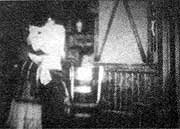 |
 |
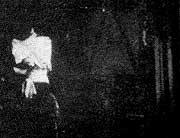 |
The Eavesdropper –
the final fade-out |
The film in which the fade-out arose was The Eavesdropper (March 5 and 8), an otherwise foregettable two-set quickie, which ends as a successful suitor embraces his girl. As they kiss, the scene fades mostly to black. (Complete fades were still a few years to come.) Although it’s hard to tell for sure (and the film is not mentioned in any of the Griffith literature or reminiscences), it appears that the effect was not achieved photographically by stopping down or irising out the lens. The clue lies in the bright reflection on the back of a chair. The light does not fall off smoothly; rather, each time it drops off a bit the reflection narrows and at last disappears, thus suggesting that a bank of key lights was extinguished one by one or, if a single light was used to illuminate the background, then its shutters were nudged progressively closed. If that is true, then it seems ironic that this prime Griffith cinematic innovation turns out to have been generated in a purely theatrical manner.
In contrast to Griffith’s technical innovations of 1908, this fade-out had no apparent thematic significance in the context of the movie in which it was introduced, nor did it enrich the story or the characters in any way. While darkening a scene can suggest growing depression, rising suspicion or lurking evil, or even serve as a literal depiction of fading light as a storm or night approaches, here we leave the couple presumably happy and facing a bright future. While the fade could be seen to function as a curtain to lend privacy to their intimacy, for the most part the effect is purely decorative and formal, providing a lingering impression and a gentle conclusion instead of the abrupt cut to a blank screen (or perhaps the Biograph logo that was used in lieu of an “End” title).
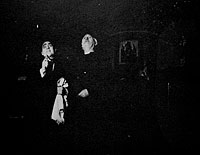 |
| A Baby's Shoe – the final fade |
In only a few years, the fade-out would become a routine standardized way of ending a movie (and its major sequences) and a corresponding fade-in would open them – also purely decorative uses. In the meantime, in several films of 1909 Griffith explored the creative potential of fade-outs. The first was A Baby’s Shoe (April 5, 6 and 12) in which a man discovers that his fiancée is in fact his long-lost sister and enters the priesthood. The final shot shows him and a senior priest kneeling to pray together as the background fades, leaving their faces fully illuminated. The effect is wonderfully suggestive of the world and its disappointments literally fading away, leaving the faithful suspended in a spiritual space free of earthly anchors. A similar concluding partial fadeout to suggest religious meditation would be found in A Strange Meeting (June 11 and 17). Next, though, was The Violin Maker of Cremona (April 21, 22 and 23), which ends after the title character loses his girl to a rival, foregoes a prize he has won, smashes his violin and returns alone to his room where the lighting begins to dim, thus clearly reflecting his state of mind. Somewhat less creatively, Fools of Fate (August 27 – 30) used a fade-out literally, but in the course of its story rather than only at the end, as two hunters bed down for the night. (Since the scene was shot outdoors, the effect must have been achieved by stopping down the lens rather than by dimming the light.)
 Griffith also began to use the opposite effect – a fade-in. The first use was in The Slave (June 22 and 23). Despite its extensive Roman period costumes and a large cast, the picture is rather dull until the final shot, which begins in nearly total darkness and then gradually brightens to reveal the main couple gazing off-screen. Griffith also began to use the opposite effect – a fade-in. The first use was in The Slave (June 22 and 23). Despite its extensive Roman period costumes and a large cast, the picture is rather dull until the final shot, which begins in nearly total darkness and then gradually brightens to reveal the main couple gazing off-screen.
 |
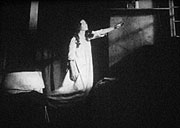 |
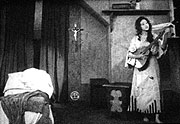 |
Pippa Passes –
the opening fade-in |
Just as the fade-in is mechanically reversed from the fade-out, Griffith’s first use implies the opposite emotional overtone of hope rather than defeat – here, the couple is looking forward to brighter times ahead. That said, Griffith’s first use of both devices in a single film was purely decorative and literal – Pippa Passes (August 17 – 21) begins as the singer of the title wakens to a brightening room as sunlight begins to stream through her window and ends as she goes to bed at nightfall, the level of lighting rising and falling (although too precipitously to be realistic) to depict sunrise and sunset. (In When the Movies Were Young (E. P. Dutton, 1925), Linda Arvidson [Griffith’s wife] recalled that the effect was produced by equipping a rectangular hole in the back wall of the set with a sliding board behind which a powerful Kleig light was placed. A New York Times review saluted the effect and likened it to the Secessionist Photographers.)
 |
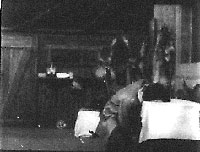 |
Fools of Fate –
the final scene |
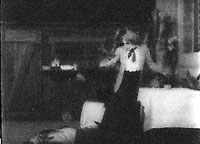 |
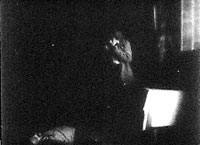 |
Before fades, Griffith had begun to experiment with using lighting expressively, rather than relying solely upon the flat, intense illumination needed for proper exposure of the insensitive film stock on interior sets. The first instance was in Edgar Allen Poe [sic] (January 21 and 23), in which the poet’s garret is rather dark (reflecting both his dejected mood and the death of his wife with which the picture ends), with the primary light source pouring in through a window. A highly effective variant emulated the glow of a fireplace to add symbolic warmth to a family scene in The Drunkard’s Reformation (February 25, 26 and 27). The Cricket on the Hearth (April 8, 19 and 24) went a step further by dousing the lights slightly to reflect a candle being extinguished, leaving the actor staring into a gleaming fireplace into which lights apparently had been placed. A more sophisticated and highly dramatic use of lighting effects closes Fools of Fate – a wife who nearly ran off with another man returns to her dark cabin, which springs to light as she opens a lantern and plans to give herself back to her husband, and then plunges back into darkness when she discovers that he has killed himself and knocks the lantern over, leaving her in abject despair. Although there are no splice marks visible in the paper print, the instantaneous changes are too rapid for the switching on and off of studio bulbs and there are slight jumps in the actress’s position at each juncture, thus suggesting that some frames were edited out. In any event, the scene is doubly powerful, as it operates on both literal and figurative levels.
 But if the fade-out, fade-in and other lighting effects had their origins in theatrical practice, the tracking shot – where the camera is mounted on a moving object – is pure cinema. But if the fade-out, fade-in and other lighting effects had their origins in theatrical practice, the tracking shot – where the camera is mounted on a moving object – is pure cinema.
Griffith had already panned and tilted the camera on its axes, but now the camera itself would move. If the most basic and distinctive trait of cinema is an ability to depict movement, then the ultimate cinematic technique is where the camera itself (and, consequently, the audience who must see from the camera’s vantage) acquires motion. Although Griffith’s first fade-out was an exception, we have repeatedly seen that one of his chief marvels is that he rarely introduces a new type of shot as a mere technical exercise, but rather manages to infuse it with a wonderfully effective and highly appropriate thematic purpose. And so it is here with his first tracking shot.
The film is A Drive For Life (January 15, March 23 and 30). The situation involves fiancés pursued by a vengeful spurned woman (dressed in black, of course). In two establishing shots, the lovers drive off in an auto down a scenic lane. The tracking shot begins with the camera seemingly fixed in the center of the road as the lovers’ car approaches. But then, as the car seems about to overrun our position, the camera itself begins to move back and pick up speed until it keeps the lovers framed tightly in the foreground. After we share a few moments of their intimacy, the spurned woman appears in pursuit in a horse-drawn buggy. The scene is held for a substantial distance so we can dwell upon the fine symbolism – the lovers (with whom we continue to identify due to their constant proximity) are blissfully unaware of the lingering threat that is literally following them from the background of the scene just as the spurned woman herself has trailed them from the background of their lives. The end of the shot is equally expressive – the car suddenly turns down a side road but the camera stays with the buggy which stops and then turns around. As it does so, the camera abruptly halts and then quickly pans down the side road where the lovers drove, so as to suggest the frustrated pursuer belatedly glancing at the route of their escape.
Beyond liberating the camera from a rigidly fixed position and perspective in favor of unlimited flexibility, the tracking shot opened the door to a vast expansion of the camera’s ability to assume a subjective role and, since it represents our own point of view, to involve us far more directly and personally in whatever is being depicted. That, in turn, imposes a heavy responsibility upon a director, since we are no longer passive observers but rather must rely upon his ability to direct our attention in ways appropriate to the narrative and tone of the evolving story.
 While the fade-out and tracking shot are Griffith’s most striking technical innovations of this period, there remains one further novelty that ultimately would prove of greater importance as a Griffith hallmark – the facial close-up. While the fade-out and tracking shot are Griffith’s most striking technical innovations of this period, there remains one further novelty that ultimately would prove of greater importance as a Griffith hallmark – the facial close-up.

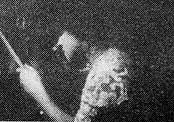 |
And a Little Child Shall Lead Them –
the facial close-up |
And a Little Child Shall Lead Them (February 22 and 24) is every bit as saccharine as its title. It opens in a child’s sickroom, with a doctor in attendance and the family pathetically wringing their hands, shaking their heads and otherwise overacting their grief. But the next shot injects a far more human element as the disconsolate mother sits at her dressing table and grasps her child’s portrait. Once this scene has barely registered after a mere five seconds, Griffith boldly cuts to a nine-second close-up of the mother, her distress literally jumping out at us.
From our modern perspective, close shots have become such a routine and clichéd part of film (and TV) grammar as to be utterly unremarkable, and so it seems excessive to describe this one in awe-struck terms. Yet the emotional power of this transition is astounding. Griffith had shown close shots of inanimate objects before – recall the inserts in Betrayed by a Handprint. He also had shown people, as in The Valet’s Wife, but always in the context of clarifying a necessary plot detail. Not so here – we can easily grasp from the establishing shot that the mother is distressed, so we really don’t need a close-up for plot, character or even sheer mood. Rather, Griffith goes right to the heart of his artistry – theme. He boldly freezes the action while we share an intimate moment with a character who, until now, had been little more than a stock melodramatic figure.
This is a great leap forward from Griffith’s prior close-ups. It is one matter to see an object at close range, but quite another to be confronted with that repository of humanity – a face. Unless the nature of an object shown in close-up is inherently shocking (the staple of cheap horror flicks), there is limited power in such a shot. But present a face and the close-up serves to magnify human feeling. More than any other technique available to filmmakers, it ensures that an audience will identify with a character and in that way vastly contributes to the personal connection we feel with a favorite movie.
Before leaving the first part of 1909, we should mention one further Griffith production, although it is an anomaly in his output.
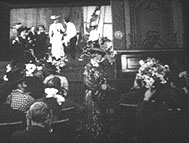
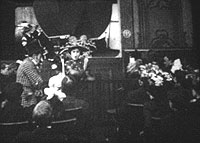
|
| Those Awful Hats – solving a 1909 fashion problem |
Those Awful Hats (January 11 and 12), a mere 2½ minutes long, consists of a single shot showing a nickelodeon where a drawing-room drama is being exhibited. (The paper print shows only a blank screen, so the “movie” was double-printed onto the positive stock using a remarkably precise traveling matte.) The audience becomes progressively more distressed by a parade of women who enter in increasingly outrageous tall flowery hats until a crane descends from above and plucks one off, and then returns to bodily hoist away the worst offender. Kemp Niver points out that a combination of flat floors and outsized fashionable headgear led many shows to begin with a lantern slide reading “Ladies Will Please Remove Their Hats,” for which this comedy was advertised as an amusing substitute.
In retrospect, Those Awful Hats is an extremely rare instance of Griffith using a mechanical contrivance, and is one of the very few Griffith comedies that still seems funny. But beyond that, by preserving a rare if somewhat overstated slice of movie-going life at the time, in which he depicts the audience as paying far more attention to themselves than to anything on the theatre screen, Griffith unwittingly bequeathed us a wry and valuable reminder that before we place his work on a pedestal of rarified artistry or analyze it in microscopic detail we ought to remember that it was a commercial product intended for simple audiences and that the occasional flashes of artistry we perceive were strictly incidental to its primary purpose.

Copyright 2010 by Peter Gutmann
{Portions of this article were published in Classic Images No. 89}
|